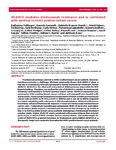ADAM10 mediates trastuzumab resistance and is correlated with survival in HER2 positive breast cancer.
| dc.contributor.author | Feldinger, K | en |
| dc.contributor.author | Generali, D | en |
| dc.contributor.author | Kramer-Marek, G | en |
| dc.contributor.author | Gijsen, M | en |
| dc.contributor.author | Ng, TB | en |
| dc.contributor.author | Wong, JH | en |
| dc.contributor.author | Strina, C | en |
| dc.contributor.author | Cappelletti, M | en |
| dc.contributor.author | Andreis, D | en |
| dc.contributor.author | Li, J-L | en |
| dc.contributor.author | Bridges, E | en |
| dc.contributor.author | Turley, H | en |
| dc.contributor.author | Leek, R | en |
| dc.contributor.author | Roxanis, I | en |
| dc.contributor.author | Capala, J | en |
| dc.contributor.author | Murphy, G | en |
| dc.contributor.author | Harris, AL | en |
| dc.contributor.author | Kong, A | en |
| dc.date.accessioned | 2016-08-09T14:57:51Z | |
| dc.date.available | 2016-08-09T14:57:51Z | |
| dc.date.issued | 2014-08-30 | en |
| dc.identifier.uri | http://hdl.handle.net/10026.1/5250 | |
| dc.description.abstract |
Trastuzumab prolongs survival in HER2 positive breast cancer patients. However, resistance remains a challenge. We have previously shown that ADAM17 plays a key role in maintaining HER2 phosphorylation during trastuzumab treatment. Beside ADAM17, ADAM10 is the other well characterized ADAM protease responsible for HER ligand shedding. Therefore, we studied the role of ADAM10 in relation to trastuzumab treatment and resistance in HER2 positive breast cancer. ADAM10 expression was assessed in HER2 positive breast cancer cell lines and xenograft mice treated with trastuzumab. Trastuzumab treatment increased ADAM10 levels in HER2 positive breast cancer cells (p ≤ 0.001 in BT474; p ≤ 0.01 in SKBR3) and in vivo (p ≤ 0.0001) compared to control, correlating with a decrease in PKB phosphorylation. ADAM10 inhibition or knockdown enhanced trastuzumab response in naïve and trastuzumab resistant breast cancer cells. Trastuzumab monotherapy upregulated ADAM10 (p ≤ 0.05); and higher pre-treatment ADAM10 levels correlated with decreased clinical response (p ≤ 0.05) at day 21 in HER2 positive breast cancer patients undergoing a trastuzumab treatment window study. Higher ADAM10 levels correlated with poorer relapse-free survival (p ≤ 0.01) in a cohort of HER2 positive breast cancer patients. Our studies implicate a role of ADAM10 in acquired resistance to trastuzumab and establish ADAM10 as a therapeutic target and a potential biomarker for HER2 positive breast cancer patients. | en |
| dc.format.extent | 6633 - 6646 | en |
| dc.language | eng | en |
| dc.language.iso | eng | en |
| dc.subject | ADAM Proteins | en |
| dc.subject | ADAM10 Protein | en |
| dc.subject | Amyloid Precursor Protein Secretases | en |
| dc.subject | Animals | en |
| dc.subject | Antibodies, Monoclonal, Humanized | en |
| dc.subject | Antineoplastic Agents | en |
| dc.subject | Breast Neoplasms | en |
| dc.subject | Cell Line, Tumor | en |
| dc.subject | Cell Proliferation | en |
| dc.subject | Drug Resistance, Neoplasm | en |
| dc.subject | Female | en |
| dc.subject | Gene Knockdown Techniques | en |
| dc.subject | Humans | en |
| dc.subject | Membrane Proteins | en |
| dc.subject | Mice | en |
| dc.subject | Receptor, ErbB-2 | en |
| dc.subject | Trastuzumab | en |
| dc.subject | Xenograft Model Antitumor Assays | en |
| dc.title | ADAM10 mediates trastuzumab resistance and is correlated with survival in HER2 positive breast cancer. | en |
| dc.type | Journal Article | |
| plymouth.author-url | https://www.ncbi.nlm.nih.gov/pubmed/24952873 | en |
| plymouth.issue | 16 | en |
| plymouth.volume | 5 | en |
| plymouth.publication-status | Published | en |
| plymouth.journal | Oncotarget | en |
| dc.identifier.doi | 10.18632/oncotarget.1955 | en |
| plymouth.organisational-group | /Plymouth | |
| plymouth.organisational-group | /Plymouth/REF 2021 Researchers by UoA | |
| plymouth.organisational-group | /Plymouth/REF 2021 Researchers by UoA/UoA01 Clinical Medicine | |
| plymouth.organisational-group | /Plymouth/REF 2021 Researchers by UoA/UoA01 Clinical Medicine/UoA01 Clinical Medicine | |
| dc.publisher.place | United States | en |
| dc.identifier.eissn | 1949-2553 | en |
| dc.rights.embargoperiod | Not known | en |
| rioxxterms.versionofrecord | 10.18632/oncotarget.1955 | en |
| rioxxterms.licenseref.uri | http://www.rioxx.net/licenses/all-rights-reserved | en |
| rioxxterms.type | Journal Article/Review | en |


